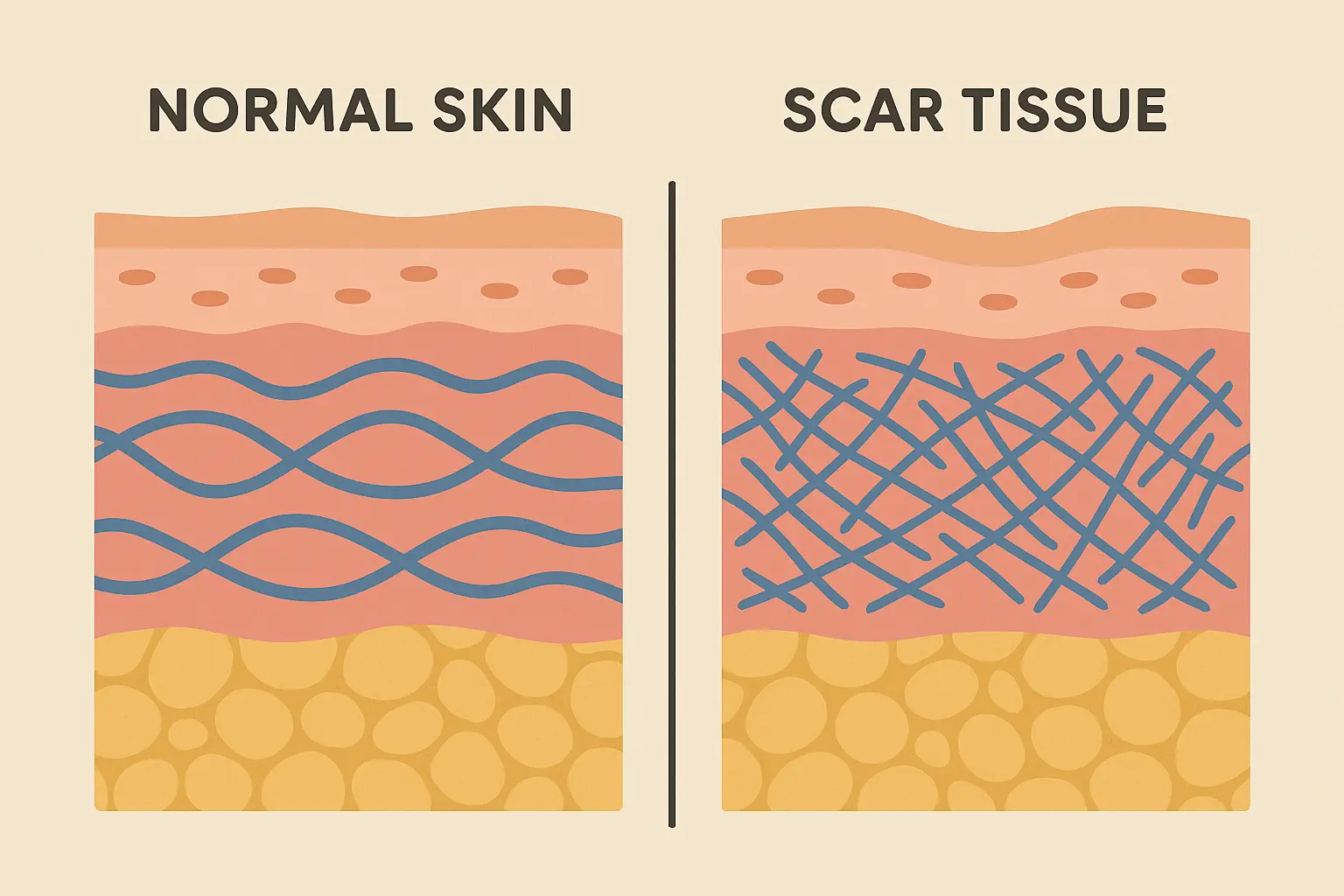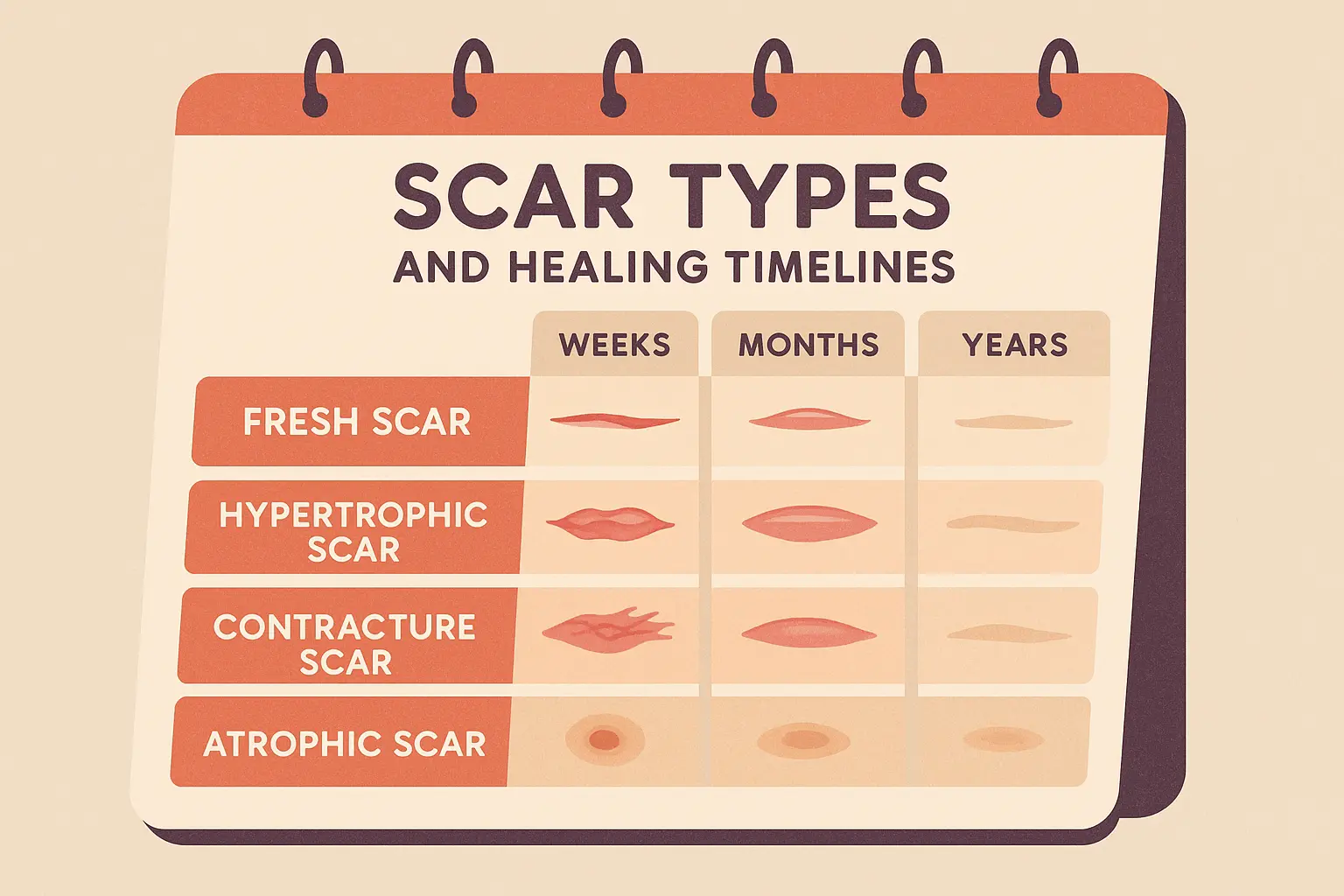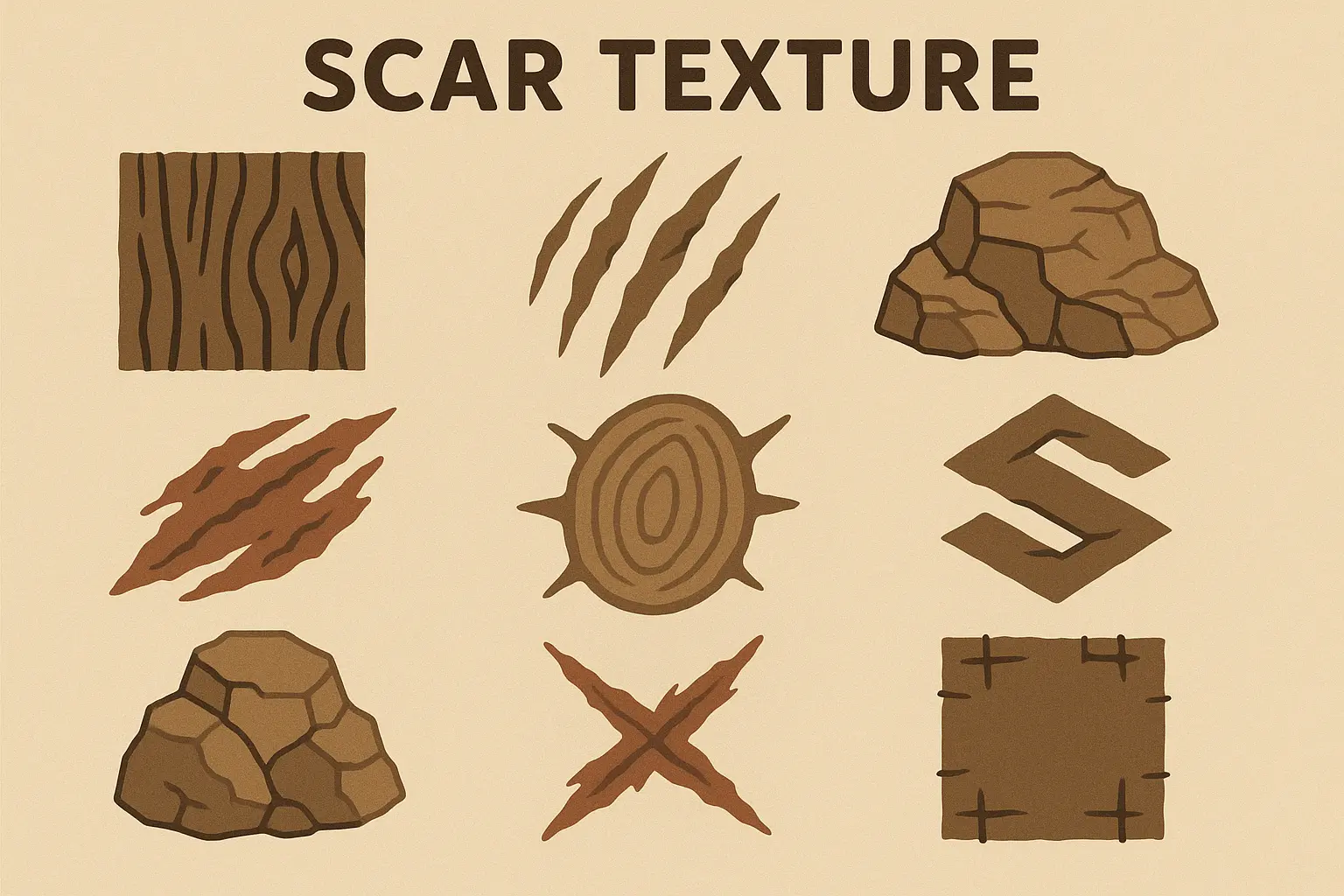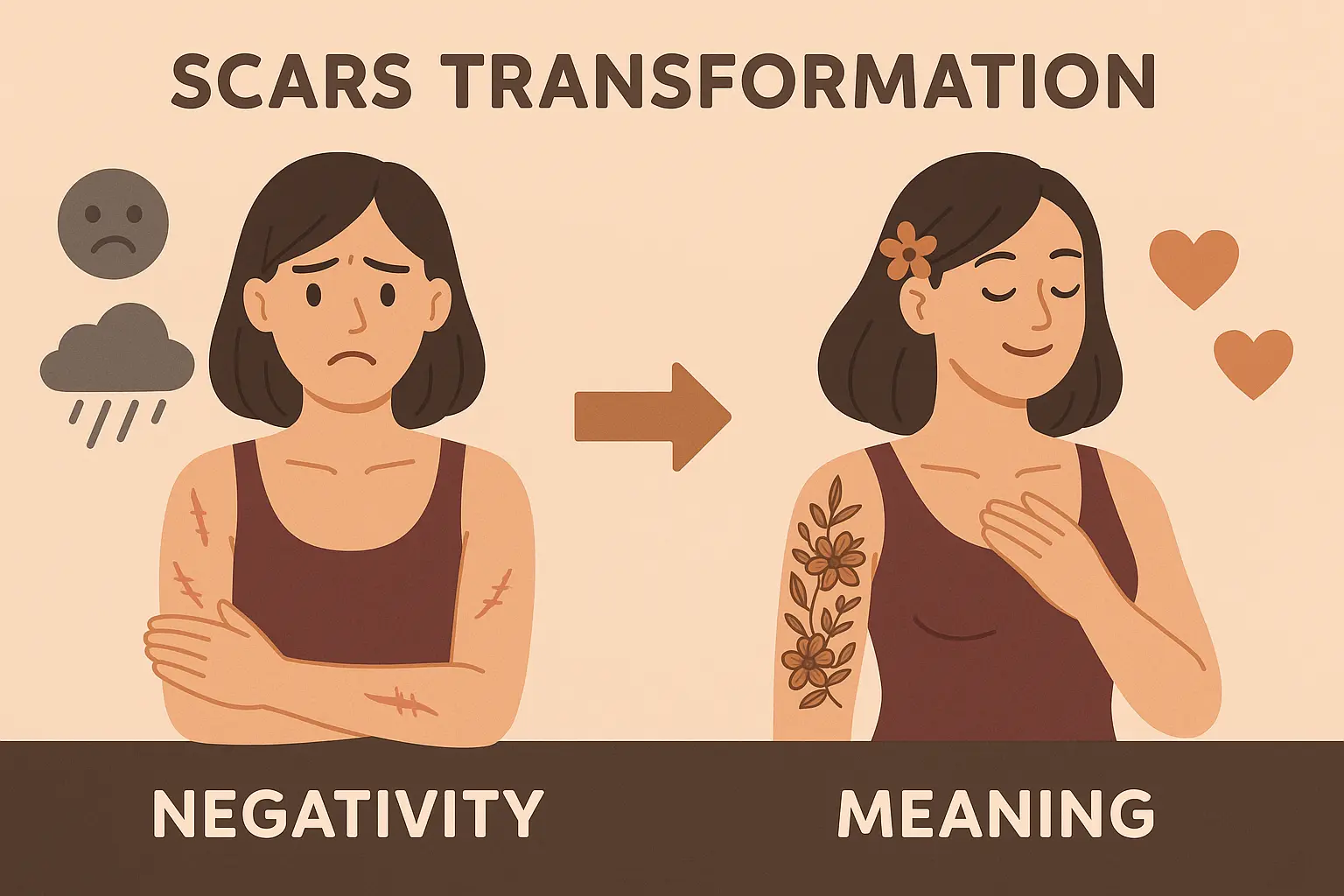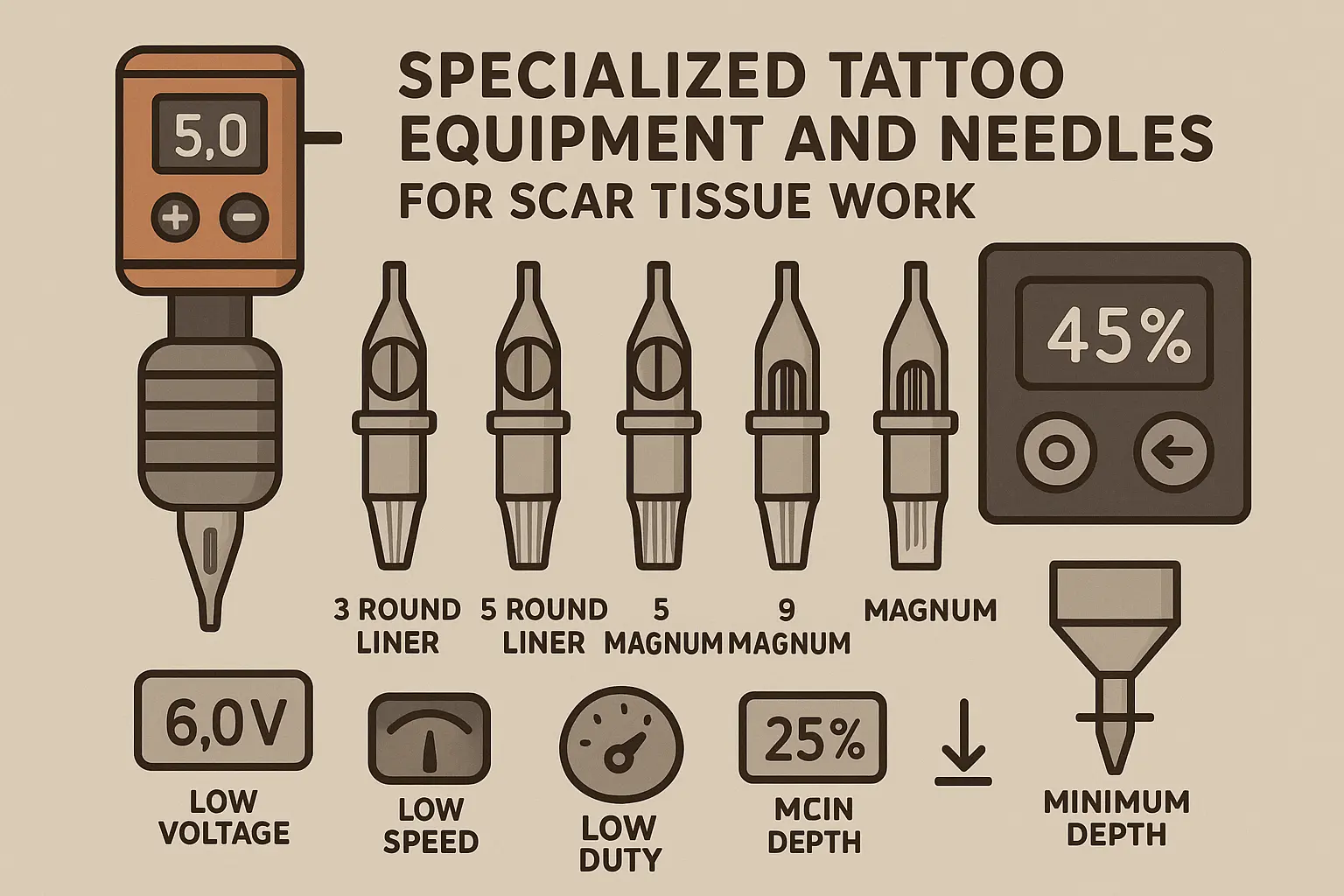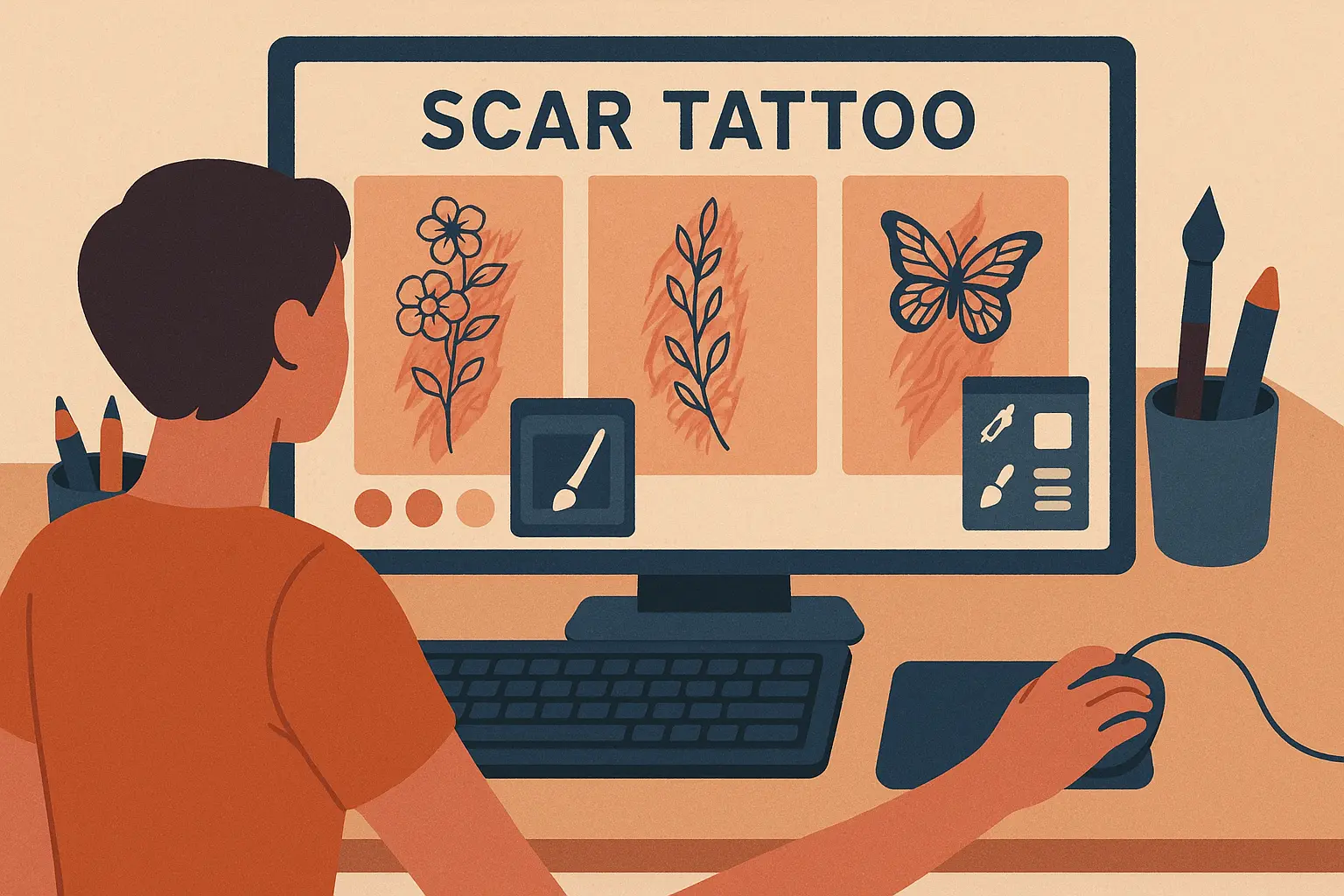Can You Tattoo Over Scars? The Real Truth About Turning Your Story Into Art

So you’ve got a scar and you’re wondering – can I get a tattoo over this thing? Short answer: yes, but it’s way more complicated than you might think. The process involves understanding how your scarred skin is totally different from regular skin, finding an artist who actually knows what they’re doing with compromised tissue, and managing expectations that are probably way off from your Pinterest inspiration board.
Table of Contents
-
The Science Behind Your Scarred Skin Canvas
-
When Timing Actually Matters (It’s Not Just One Year)
-
Design Strategies That Work With Your Scars
-
Finding the Right Artist for Scar Work
-
The Emotional Journey of Scar Transformation
-
Technical Stuff Your Artist Needs to Know
-
Legal and Medical Considerations You Can’t Ignore
TL;DR
-
Your scar tissue is basically a different material than regular skin – it’s tougher, less stretchy, and acts weird with tattoo needles and ink
-
That “wait one year” rule everyone talks about? It’s way too simple – some scars need 18-24 months to be ready
-
The best scar tattoos don’t try to hide your scar – they make it part of the art
-
You need an artist who’s done this before, not just someone who’s really good at regular tattoos
-
Black and dark blue inks work best on scars, while reds and yellows can look muddy or fade fast
-
This is as much about emotional healing as making things look pretty
-
Some scars need your doctor’s permission first, especially surgical ones
The Science Behind Your Scarred Skin Canvas
Here’s the thing nobody tells you upfront – your scar isn’t just “damaged skin that healed.” It’s basically a completely different material with its own weird properties. Think of it like this: if regular skin is stretchy canvas, scar tissue is more like leather. That changes everything about how a tattoo needle works on it.
How Scar Formation Rewrites Your Skin’s Blueprint
When your skin heals from an injury, your body doesn’t just patch things up with the same materials. It’s like your contractor ran out of the original supplies and had to improvise with whatever was in the truck. The end result works, but it’s built differently.
The Collagen Flip That Changes Everything
Here’s where it gets weird – your body literally uses different building blocks when it makes scar tissue. Regular skin is built mostly with Type I collagen (think strong, flexible), but scars get made with more Type III collagen during healing. It’s like switching from elastic fabric to stiff canvas.
What this means for you: Your tattoo artist can’t just use their normal settings and hope for the best. The needle hits more resistance, the ink doesn’t spread the same way, and they need to completely adjust their technique. Artists who don’t get this will struggle with getting consistent lines or might accidentally trauma your tissue even more.
Normal skin is about 80% Type I collagen and 20% Type III collagen, but scar tissue flips this ratio during formation. This creates tougher, less flexible tissue that your tattoo needle has to fight through.
Blood Flow Gets Weird in Scarred Areas
Your scar’s blood supply isn’t just “less than normal” – it’s completely reorganized in unpredictable ways. Some spots might have almost no blood flow, while others develop these weird clusters of new vessels that bleed like crazy when you tattoo them.
This vascular weirdness messes with how well your tattoo holds. Areas with poor blood flow might not grab onto the ink well, leaving you with patchy spots. Areas with too much blood flow might push the ink around while it’s healing, making your lines look blurry or muddy.
Maria learned this the hard way when she got her mastectomy scar tattooed. Half of her beautiful vine design healed perfectly, but the other half where her blood flow was patchy ended up looking faded and uneven. She needed two additional sessions to get it right.
Why Your Scar Feels Different Under the Needle
If you’ve ever touched your scar, you know it feels different – maybe numb in some spots, weirdly sensitive in others, or just… off. All of that weirdness affects how tattooing feels and works on scar tissue.
The Stretch Factor Reality Check
Your scar doesn’t stretch like normal skin. At all. This means when your artist is working, the skin doesn’t “give” the way they’re used to. Instead of the needle gliding smoothly, it might bounce or skip. Some artists compensate by pressing harder, which can damage tissue that’s already compromised.
The lack of stretch also affects how the skin moves during the tattoo process. Normal skin stretches and snaps back, helping close up those tiny needle holes quickly. Scar tissue just… doesn’t. Those holes stay open longer, which can mess with how well the ink stays put.
Mature scar tissue typically has 20-30% less stretch than normal skin. If your artist doesn’t adjust for this, you could end up with ink blowouts (where the ink spreads beyond the lines) or spots where the needle didn’t penetrate deep enough.
Navigating Bumps, Dips, and Texture Changes
Raised scars are tricky because your artist has to change their angle constantly to follow the contours. It’s like trying to color on a bumpy surface – you can’t just use the same technique everywhere.
Sunken scars have the opposite problem. The needle might go too deep in the low spots, causing blowouts or just plain hurting more than it should. Good artists learn to “read” your scar’s landscape and adjust constantly.
Jake’s burn scar had both raised and depressed areas. His first artist treated it like normal skin and ended up with a mess – thick, blown-out lines in the low spots and patchy coverage on the raised parts. His second artist (who actually knew scar work) took twice as long but got it right.
The Pain Perception Paradox
This is the part that catches people off guard – scar tissue has completely unpredictable pain responses. You might feel absolutely nothing in one spot and then want to jump off the table two millimeters away. It’s not just uncomfortable; it messes with your artist’s ability to work consistently.
Numb spots might tempt your artist to work more aggressively since you can’t feel it, but that can cause damage you won’t notice until later. Super sensitive spots might need constant breaks or special techniques to stay tolerable.
What this means for you: Don’t expect your scar tattoo to feel like a regular tattoo. It might be completely painless, excruciating, or weirdly inconsistent. Talk to your artist about this beforehand so you’re both prepared.
For those concerned about pain levels during the process, understanding tattoo pain scales can help prepare for the unique sensations that come with scar tattooing.
According to professional tattoo artists, it could take up to a year for deeper scars to completely heal before they’re ready for tattooing, with the healing timeline directly impacting how the tissue will respond to needle penetration and ink retention.
When Timing Actually Matters (It’s Not Just One Year)
Everyone’s heard the “wait one year” rule, but here’s the truth – that’s way too simple and honestly kind of misleading. Different scars heal at completely different speeds, and rushing into it because you hit that magical 12-month mark can lead to disappointing results or even make your scar worse.
Beyond the Oversimplified One-Year Rule
The waiting period sucks. There’s no sugar-coating it. When you’re ready to transform that scar into something beautiful, being told to wait longer feels like torture. But here’s why it matters – and why the timeline varies so much.
Clean Cuts vs Chaotic Wounds
Surgical scars have a head start because surgeons are basically professional wound-makers. They know exactly how to cut and how to close things up for optimal healing. These scars usually follow a more predictable timeline because the damage was controlled from the start.
Traumatic scars? Completely different story. Car accidents, burns, random injuries – these create chaotic tissue damage that takes way longer to sort itself out. Your body has to work harder to figure out how to rebuild, and the end result is often more unpredictable.
Tom learned this lesson the hard way. He waited exactly one year after his motorcycle accident and got his road rash scars tattooed. The ink didn’t take evenly, some areas got infected, and he ended up with a patchy mess that needed to be covered up again. If he’d waited another six months, his artist said it probably would have gone smoothly.
Surgical scars from planned procedures typically mature within 12-18 months with predictable healing patterns, while traumatic scars from accidents or injuries may require 18-24 months due to irregular tissue damage and more complex healing.
|
Scar Type |
Typical Healing Timeline |
Key Considerations |
|---|---|---|
|
Surgical (clean incisions) |
12-18 months |
Predictable healing, organized tissue |
|
Traumatic (accidents, burns) |
18-24 months |
Irregular damage, complex healing |
|
Self-harm scars |
18-24 months |
Often multiple layers, emotional considerations |
|
Stretch marks |
12-18 months |
May not hold ink as well as other scars |
|
Keloid scars |
24+ months |
May keep growing, needs doctor approval |
Body Geography Affects Healing Speed
Where your scar lives on your body makes a huge difference in how fast it heals. Scars on parts that move a lot – elbows, knees, shoulders – never get a break from being stretched and pulled. It’s like trying to let a cut on your knuckle heal while you keep making fists.
Areas that don’t move much, like your back or upper arms, usually heal closer to that standard timeline. Your face is weird because the skin is thin but has amazing blood supply, so facial scars can be unpredictable.
Sarah’s C-section scar was ready at 14 months, but her elbow scar from the same accident needed almost two years because it kept getting stretched every time she bent her arm.
Why Fresh Scars and Tattoos Don’t Mix
Let’s be brutally honest here – trying to tattoo a fresh scar is asking for trouble. Multiple kinds of trouble. Your immune system is still in cleanup mode, your tissue is still rebuilding, and adding tattoo trauma to the mix is like trying to renovate a house that’s still under construction.
The Immune System Conflict
Your immune system doesn’t know the difference between “healing this wound” and “attacking this foreign tattoo ink.” When you try to do both at the same time, it gets confused and does neither job well. You end up with poor ink retention, weird healing, and inflammation that goes on way longer than it should.
Think of it like this – your body’s repair crew is already working overtime on your scar. Adding tattoo ink to the job site just creates chaos and nobody gets their work done properly.
Interrupting Nature’s Repair Process
Even when your scar looks “healed” on the surface, there’s still major construction happening underneath. Your body is reorganizing collagen, rebuilding blood vessels, and basically doing a complete renovation project that can take months or even years.
Tattooing during this phase is like jackhammering while the foundation is still being poured. You might end up with a worse scar than you started with, plus a tattoo that doesn’t look good either.
Lisa was so eager to cover her surgical scar that she found an artist willing to work on it at eight months. The tattoo disrupted her healing so much that she ended up with a raised, angry-looking scar AND a tattoo that looked muddy and uneven. She had to wait another year and start over with a different artist.
Real Talk: Your Instagram-perfect tattoo dreams might need adjusting. Scar tissue doesn’t always cooperate with Pinterest inspiration boards, and rushing the timeline usually makes everything worse.
Design Strategies That Work With Your Scars
Here’s where most people get it wrong – they want their tattoo to completely hide their scar, make it invisible, pretend it never happened. But the best scar tattoos don’t fight against the scar – they work with it. It’s like the difference between trying to hide a speed bump and turning it into part of your driveway design.
Embracing Your Scar as Part of the Art
This mindset shift is huge, and honestly, it can be emotional. You’re going from “I want to hide this thing” to “I want to make this thing beautiful.” That’s a big mental leap, but it’s where the magic happens.
Using Raised Tissue for Natural Dimension
Raised scars actually give you something most tattoos can’t have – real, physical dimension. Instead of trying to flatten that texture visually, smart designs use it as built-in 3D effects. Tree bark that actually feels like bark? Mountain ranges with real peaks and valleys? You can’t get that on normal skin.
I saw this incredible transformation where a woman’s keloid scar from a childhood burn became a mountain range in a landscape piece. The raised tissue created natural shadows and highlights that made the mountains look like they were actually jutting out of her skin. It was stunning in a way that a flat tattoo never could be.
But this approach requires an artist who can think three-dimensionally about tattoo design. Not everyone has this skill set, which is why finding the right person is so crucial.
Turning Depressions into Natural Shadows
Sunken scars create natural shadow areas that can be incredibly effective in the right design. These depressions can become the centers of flowers, the depths of water features, or recessed architectural details
The natural shadowing adds realism that would be impossible to achieve on flat skin.
Mike’s atrophic acne scars became the perfect texture for a stone wall design. Each little depression looked like natural weathering and aging in the stone. What he’d always seen as damage became the most realistic part of his tattoo.
The key is designing around these features rather than trying to fill them in or hide them. When you work with your scar’s natural topology, the results can be breathtaking.
Strategic Color Choices for Scar Coverage
Let’s talk about color reality – scar tissue is picky about tattoo ink. Some colors work great, others look like garbage, and some just disappear entirely. Understanding this upfront can save you from disappointment later.
Why Some Colors Work Better on Scars
Black and dark blue are your friends when it comes to scar tattooing. These pigments have larger particles that tend to stay put better in scar tissue’s weird collagen structure. They’re also more chemically stable in the altered environment of scarred skin.
Red and yellow? They’re drama queens on scar tissue. The altered blood flow can make reds look muddy or uneven, and yellows often fade faster because your immune system in scar areas tends to be more active and might attack the pigment.
This doesn’t mean you can’t use these colors – it just means you need to be strategic about where you put them. Maybe use the tricky colors on normal skin areas and stick with reliable pigments directly over the scar tissue.
Jessica learned this when her rose tattoo over a surgical scar ended up with muddy red petals and yellow centers that faded to almost nothing within six months. Her touch-up session focused on darker colors and the results were much better.
Black and dark blue pigments typically show the best retention in scar tissue due to their larger particle size and chemical stability, while red and yellow pigments may appear uneven or fade more quickly due to altered blood flow in scarred areas.
Compensating for Reduced Color Vibrancy
Scar tissue just doesn’t hold color as vibrantly as normal skin. It’s like the difference between painting on white canvas versus painting on gray paper – everything comes out a little muted. Experienced artists know this and compensate by cranking up the saturation during application.
But there’s a fine line here. Too little saturation and your colors look washed out. Too much and you get blowouts where the ink spreads beyond the lines, creating muddy results. This is where artist experience really shows.
Your artist might need to go over areas multiple times or use different techniques to get the color intensity right. This means longer sessions and potentially higher costs, but it’s worth it for good results.
Real Talk: That vibrant watercolor tattoo you saw on Instagram? It’s not going to look the same on scar tissue. Plan for more muted colors and work with your artist to find a style that looks amazing even when it’s not Instagram-bright.
When planning your design colors, exploring flower tattoo designs can provide inspiration for incorporating natural color gradients that work well with scar tissue limitations.
Marcus had a large burn scar on his forearm that he wanted covered with a phoenix design. His artist strategically used black and deep purple for the phoenix’s body directly over the scar tissue, while incorporating bright oranges and reds in the flames that extended onto normal skin. This approach ensured the core design remained vibrant while working with the scar’s limitations rather than against them.
Finding the Right Artist for Scar Work
This is where a lot of people mess up. They find an artist with a gorgeous portfolio and assume that means they can handle scar work. But tattooing scars is like being a regular mechanic versus being able to work on vintage cars – similar skills, completely different expertise.
Beyond Pretty Portfolio Pictures
A beautiful Instagram feed doesn’t mean someone knows how to work with compromised skin. You need to dig deeper and ask specific questions that will reveal whether they actually understand what they’re getting into.
The Paramedical Tattoo Connection
Here’s a secret qualification most people don’t know to look for – paramedical tattoo experience. Artists who’ve done areola reconstruction, vitiligo camouflage, or medical scar work understand compromised skin in ways that regular tattoo artists just don’t.
These artists have dealt with weird skin texture, unpredictable healing, and the psychology of working with clients who have medical concerns. They’re also more comfortable working with doctors and understanding medical clearance requirements.
When you’re interviewing artists, ask specifically: “Have you done any paramedical tattoo work?” Even a little experience in this area gives them a huge advantage over artists who’ve only worked on perfect skin.
Testing Your Artist’s Skin Science Knowledge
A qualified scar tattoo artist should be able to explain what they’re doing, not just show you pretty pictures. They should understand why different types of scars need different approaches, what affects healing times, and how to tell if your scar is actually ready for tattooing.
During your consultation, pay attention to how they evaluate your scar. Do they ask about how you got it, how long ago, what your healing was like? Can they explain why certain design approaches might work better than others? Do they talk about realistic timelines without trying to rush you into booking?
If an artist just says “I’ve done lots of tattoos” without showing specific scar knowledge, keep looking. You want someone who can talk about collagen types, not just color theory.
Sarah interviewed five artists before finding the right one. The first four looked at her C-section scar and said “no problem, we can cover that.” The fifth artist spent 20 minutes examining the scar, asking about her healing process, and explaining why certain design elements would or wouldn’t work. Guess which one got the job?
The Consultation Deep Dive
A good scar tattoo consultation should feel more like a medical appointment than a regular tattoo consultation. There should be lots of questions, detailed examination, and honest discussion about what’s realistic and what isn’t.
Understanding Your Scar’s Origin Story
Your scar’s backstory matters way more than you might think. How it happened, how it healed, what treatments you’ve had – all of this affects how it will respond to tattooing. A thorough artist wants to know everything.
Surgical scars from different procedures heal differently. A clean appendectomy scar behaves differently than a trauma surgery scar. Burns create different tissue changes than cuts. Your artist needs this information to plan properly.
Previous treatments matter too. If you’ve had steroid injections, laser treatments, or other scar therapies, these change the tissue properties. Your artist needs to know what they’re working with.
Managing Realistic Expectations
Here’s where you need to hear some hard truths. Scar tattooing takes longer than regular tattoos. It costs more. It requires more sessions. The healing period is longer. And the results might not be exactly what you pictured in your head.
A good artist will be brutally honest about these realities upfront. They’ll show you realistic examples of scar work, not just their best pieces. They’ll talk about potential complications and what happens if things don’t go perfectly.
This conversation can be disappointing if you had unrealistic expectations, but it’s better to know now than be surprised later.
Questions to Ask Potential Artists:
-
“Can you show me photos of scar work you’ve done, not just your regular portfolio?”
-
“What’s the worst scar tattoo outcome you’ve had, and why did it happen?”
-
“How many scar tattoos do you do in a typical month?”
-
“What would you do if my scar doesn’t take the ink evenly?”
-
“Do you have relationships with medical professionals for referrals?”
Understanding the financial commitment proves crucial, as specialized scar work often costs more than standard tattoos – our comprehensive tattoo pricing guide can help you budget for this specialized service.
Let’s talk money – scar tattoos cost more. A lot more. We’re talking potentially 2-3x regular tattoo prices because of the extra time, specialized skills, and multiple sessions needed.
The Emotional Journey of Scar Transformation
This part gets real, fast. The decision to tattoo over a scar isn’t just about aesthetics – it’s about your relationship with your body, your trauma, and your identity. Some days you’ll love your scar, some days you’ll hate it, and that’s totally normal.
Rewriting Your Body’s Story
There’s something incredibly powerful about choosing to transform a scar. You’re going from being a passive victim of whatever created that scar to actively deciding what it represents. That shift can be life-changing.
From Victim to Author
Every time you looked at your scar before, it probably reminded you of the accident, surgery, or trauma that created it. Getting it tattooed forces you to engage with that part of your body in a completely new way. Instead of avoiding it or hiding it, you’re actively working with it.
The process itself creates new memories too. Working with your artist, watching the design come to life, the satisfaction of seeing it completed – these positive experiences can help override those negative associations.
Many people describe feeling like they’ve “reclaimed” their body after a successful scar tattoo. The area that once represented trauma becomes a chosen expression of who they are now.
But let’s be honest – some people think getting a tattoo over their scar will fix how they feel about their body. Sometimes it does. Sometimes it doesn’t. And that’s okay to admit.
Creating New Memory Associations
Your scar used to be a reminder of the worst day, the scary diagnosis, the accident you survived. After tattooing, it becomes a reminder of your choice to transform, your collaboration with an artist, your decision to turn something painful into something beautiful.
This mental shift can be surprisingly powerful. Instead of seeing damage, you see art. Instead of remembering trauma, you remember transformation.
The emotional significance of scar tattoos has gained public attention, with celebrities such as “Teddi Mellencamp showing off meaningful new tattoo over surgery scar” Page Six, demonstrating how transformative these procedures can be for personal healing and self-expression.
Addressing Body Image Challenges
Let’s address the elephant in the room – what if covering your scar actually draws more attention to it? A large, colorful tattoo might get more looks and questions than your original scar ever did.
Understanding Your Motivation
Before you commit to this, really examine why you want it. Are you doing this for yourself – to reclaim your story, to transform your relationship with that part of your body? Or are you trying to meet someone else’s expectations about how you should look?
The most successful scar tattoo experiences happen when people are doing it for themselves. If you’re still processing the original trauma, the intensive tattoo process might be overwhelming emotionally.
Your family might not get it. “Why are you drawing attention to it?” they’ll ask. Have an answer ready, or just tell them it’s none of their business. This is your body and your choice.
When Covering Actually Draws More Attention
Here’s something nobody warns you about – your beautiful new tattoo might actually get more attention than your scar ever did. People will ask about it, want to know the story, compliment your ink. If your goal was to make the area less noticeable, this might backfire.
But here’s the thing – most people find they prefer questions about their cool tattoo to questions about their scar. The conversations become about your artistic choices rather than your medical history.
You might cry during your first consultation, and that’s totally normal. This process brings up a lot of emotions that you might not expect.
For those considering meaningful designs that reflect personal growth, exploring meaningful tattoo concepts can help identify symbols that truly represent your transformation journey.
Technical Stuff Your Artist Needs to Know
Now we’re getting into the nitty-gritty technical details that separate artists who can handle scar work from those who can’t. This isn’t just about artistic skill – it’s about understanding how to modify equipment, techniques, and aftercare for skin that doesn’t behave normally.
Equipment Modifications for Scar Tissue
Your artist can’t just use their regular setup and hope for the best. Scar tissue demands different approaches, from needle choices to machine settings to aftercare products.
Choosing the Right Needle Configuration
Think of it like this – tattooing dense scar tissue with the wrong needle is like trying to sew leather with a needle meant for silk. It’s not going to work well, and you might damage both the needle and the material.
Dense, thick scar tissue usually needs single needles or tight groupings to penetrate effectively. Softer scar areas might handle larger configurations for shading work. The tricky part is that many scars have different densities in different areas, so your artist might need to switch needles multiple times during one session.
This flexibility is essential, but it also means longer sessions and potentially higher costs. Your artist needs to constantly assess and adapt their approach.
Machine Settings That Actually Work
Here’s where experience really shows. Scar tissue typically needs higher voltage to achieve proper penetration – usually 10-15% more than normal skin. But there’s a narrow window between “adequate penetration” and “tissue damage.”
The challenge is that scar tissue isn’t uniform. Within a single scar, you might have areas that need different settings. Skilled artists make these adjustments constantly throughout the session, reading how the tissue responds and adapting in real-time.
Too aggressive and you’ll damage already compromised tissue. Too gentle and the ink won’t penetrate properly, leading to patchy, faded results.
|
Scar Tissue Type |
Recommended Needle Config |
Voltage Adjustment |
Special Considerations |
|
|---|---|---|---|---|
|
Hypertrophic (raised) |
Single needles, tight liners |
+15% |
Multiple passes, gentle pressure |
|
|
Atrophic (depressed) |
Magnums for filling |
+10% |
Avoid over-penetration |
|
|
Keloid |
Single needles only |
+10% |
Medical clearance required |
|
|
Surgical (mature) |
Standard configurations |
+5-10% |
Even healing, predictable |
|
|
Burn scars |
Variable by area |
+10-20% |
Texture varies significantly |
Extended Healing Protocols
Your scar tattoo is going to be a drama queen during healing. It’ll take longer, complain more, and need extra attention. Plan for it.
Protecting Already Compromised Skin
Scar tissue starts with a compromised protective barrier, and tattooing temporarily makes it worse. This means extended aftercare – longer periods of protective covering, more frequent cleaning and moisturizing, and extended activity restrictions.
What might be a two-week healing process on normal skin could take four to six weeks on scar tissue. The products you use might need to be different too – specialized moisturizers designed for compromised skin barriers rather than standard tattoo aftercare.
Jessica thought she could go back to the gym after a week like her friend did with her regular tattoo. Her scar tattoo took three months to heal properly and she needed touch-ups because she didn’t follow the extended aftercare protocol.
Managing Extended Inflammatory Responses
Inflammation after tattooing scar tissue can last 2-3 times longer than normal. This extended inflammatory response is usually normal for scar tissue, but it can be scary if you’re not expecting it.
The key is knowing the difference between normal extended inflammation and signs of infection or complications. Your artist should prepare you for what to expect and give you clear guidelines for when to be concerned.
Anti-inflammatory protocols become more important with scar tattoos. This might include specific medications, cold therapy, or activity modifications that go way beyond typical tattoo aftercare.
Professional scar tattoo artists report that ink will appear lighter on scarred areas compared to unmarked skin, requiring artists to adjust their saturation techniques and potentially schedule additional sessions for optimal color matching.
Bottom line: Don’t book anything until you’ve had at least two consultations with an artist who specializes in scar work. And budget for this taking longer and costing more than a regular tattoo.
Legal and Medical Considerations You Can’t Ignore
The paperwork for scar tattoos is intense. Don’t panic – it’s just everyone covering their bases. But there are some real legal and medical considerations that you need to understand before you get started.
When You Need Doctor Approval
Some scars absolutely require your doctor’s blessing before any reputable artist will touch them. This isn’t just bureaucracy – it’s about your safety and legal protection for everyone involved.
Post-Surgical Clearance Requirements
If your scar is from surgery, you need your surgeon’s approval. Period. Different surgical specialties have different comfort levels with tattooing over their work. Your plastic surgeon might be totally cool with it, while your cardiac surgeon might be more conservative about chest procedures.
Some surgeries involve hardware under the skin – mesh, plates, screws, whatever. Your surgeon knows what’s under there and whether tattooing could interfere with it or cause problems if you need future procedures.
The clearance process usually means another appointment with your surgeon. They’ll check how your scar healed, discuss any concerns specific to your procedure, and either give you written clearance or recommend waiting longer.
Chronic Conditions That Complicate Things
Diabetes, autoimmune conditions, blood disorders – these don’t automatically disqualify you from scar tattooing, but they do require medical oversight. Your doctor needs to assess whether your condition is well-controlled and whether tattooing poses additional risks.
Some conditions might require timing the tattoo around medication schedules or require special monitoring during healing. Others might need modified aftercare protocols that your artist needs to understand.
Be upfront with both your doctor and your artist about any health conditions. Trying to hide them helps nobody and could put your health at risk.
The importance of medical oversight became evident when “Kentucky’s proposal to ban tattooing over scars drew criticism” LPM, with medical experts noting that blanket bans ignore the legitimate therapeutic benefits of scar tattooing when done with proper medical clearance and professional oversight.
Understanding Professional Boundaries
Your tattoo artist isn’t a doctor, and they can’t make medical promises about your scar. They can discuss artistic outcomes and their experience with similar scars, but they shouldn’t claim that tattooing will improve your scar’s medical properties.
What Artists Can and Cannot Promise
Good scar tattoo artists stick to what they know – art, technique, and aesthetic outcomes. They don’t make medical claims about scar improvement or healing benefits. If an artist starts talking like a doctor, that’s a red flag.
This boundary protects everyone. Artists who overstep into medical territory expose themselves to liability, while clients who get medical advice from unqualified sources might make decisions that affect their health.
The best scar tattoo artists maintain relationships with medical professionals and aren’t hesitant to refer you for medical consultation when appropriate.
Enhanced Documentation Requirements
The consent process for scar tatto work is way more involved than regular tattoo consent. Your artist needs to document your scar’s history, any medical clearances you’ve gotten, and your understanding of the increased risks and longer timelines.
This documentation protects both of you by making sure everyone understands the unique challenges and realistic expectations. It also creates a record of the decision-making process if questions come up later.
Many experienced scar tattoo artists require multiple consultations before they’ll start work. They use this time to thoroughly assess your scar, discuss options, and make sure you’re making an informed decision rather than an impulsive one.
Medical Clearance Checklist:
-
Get written clearance from your operating surgeon (for surgical scars)
-
Provide complete scar history and healing timeline
-
List all medications and medical conditions
-
Document any previous scar treatments (lasers, injections, etc.)
-
Include photos showing current scar condition
-
Specify any implanted materials or hardware
-
Get approval for specific tattoo timing
-
Understand activity restrictions during healing
-
Plan follow-up appointments if needed
-
Keep all documentation for your tattoo artist
Jennifer’s keloid scar from a childhood burn required extensive documentation before her artist would proceed. The process included medical clearance from her dermatologist, a patch test for ink allergies, three separate consultations to plan the design, and signed acknowledgment that the raised tissue might remain visible despite the tattoo coverage. While time-consuming, this thorough approach resulted in a successful transformation that enhanced rather than fought against her scar’s natural texture.
How Tattoo Generator IQ Can Help Your Scar Transformation Journey
Planning a scar tattoo is way more complex than a regular tattoo. You need to visualize how different designs will work with your specific scar characteristics, and that’s hard to do just by looking at other people’s work or trying to imagine it.
This is where Tattoo Generator IQ becomes incredibly valuable. The AI technology can help you explore design concepts that specifically work with scar tissue challenges. You can experiment with approaches that incorporate your scar’s texture as artistic elements, play with color choices that work well on compromised skin, and visualize how different styles might look.
The educational resources become especially important when you’re planning scar work, since understanding both the artistic vision and technical execution is crucial for success. The platform’s guides help you have more productive conversations with specialized scar tattoo artists, so you go into consultations with both creative ideas and technical understanding.
Whether you’re exploring geometric patterns that could use raised scar tissue as natural dimension, delicate designs that work with skin texture variations, or meaningful symbolic pieces that transform trauma into triumph, Tattoo Generator IQ provides the design exploration and educational support you need for this specialized transformation.
Your homework: Take photos of your scar in different lighting conditions and use them as reference when exploring design options. This helps you see how different artistic approaches might work with your scar’s specific characteristics.
For those seeking inspiration for meaningful transformation designs, exploring cover-up tattoo concepts can provide valuable insights into artistic approaches that work with challenging skin conditions.
Final Thoughts
Look, this isn’t easy. It’s not quick. It’s not cheap. But for a lot of people, it’s life-changing. Just go in with your eyes wide open and the right team in your corner.
The science behind scar tissue is complex, finding the right artist is crucial, and the emotional journey can be as significant as the physical transformation. But when it’s done right, the results can be incredible – not just aesthetically, but emotionally too.
Remember that this process takes time – often way more time than you initially expect. That “one year rule” is just a starting point, and your specific situation might require more patience. The artists who specialize in this work understand these complexities and can guide you through realistic timelines and expectations.
Most importantly, approach this as a collaboration between you, your chosen artist, and potentially your medical team. The best outcomes happen when everyone involved understands the unique challenges and works together toward your vision.
Your scars tell a story of survival, healing, and resilience. Transforming them through tattoo artistry doesn’t erase that story – it rewrites it in your own words, with your chosen imagery, creating something that celebrates your journey rather than hiding from it.
Find online communities of people who’ve done this. Reddit, Facebook groups, Instagram hashtags – you’re not the first person to go through this journey, and connecting with others who understand can be incredibly helpful for both practical advice and emotional support.
The waiting period sucks, the process is intense, and the results might not be exactly what you pictured. But if you do your research, find the right artist, get proper medical clearance when needed, and go in with realistic expectations, you might just end up with something beautiful that changes how you feel about that part of your body forever.

